For those of you who did not see the article about our new Village Sign in the January edition of local magazine Hassocks Life, please read on! Alternatively you can see a copy of the published magazine article by clicking here.
A Village Sign had been on the Parish Council agenda for some years. When the long-standing sign, positioned in the entrance to the Adastra Park, blew down over a windy weekend in Spring 2021, the time had definitely come to turn this aspiration into a reality.
The previous sign in Adastra Park was erected in 1977, 44 years ago. It formed part of the celebrations to commemorate the Queen’s Silver Jubilee, in June 1977. The wording on the old sign referred to the ‘Parish of Keymer’ ‘George Vth and Elizabeth II,’ and ‘1910-1977’.
The sign included various heraldic symbols, including Martlets and Lions Rampant, and was enclosed in a metal frame topped with a crown. The sign was painted onto a sheet of Marine ply and lasted for far more years than anyone may have expected.
This sign had come to a natural end and so opened the door for something new and more appropriate to represent the village of Hassocks. Meanwhile, around the same time, a local Sussex based artist, Joanna Myles, had contacted the Council enquiring about plans for a new sign.
The burning question was, what should the fresh sign be like? The general consensus was for a more typical village sign which identified in words the name of the village and including pictorial references to local landmarks and /or historical features.
THE DESIGN PROCESS
In 2000, the historical Parish Councils of Clayton and Keymer were amalgamated to form a single council–Hassocks Parish Council. The Council was keen for a new sign to acknowledge all three localities which form the Parish of Hassocks and so they agreed that the design should display the name of Hassocks, but encompass the original parishes of Clayton and Keymer, as well as Hassocks.
The Council resolved to find local skilled crafts persons to fabricate this sign, and so following on from her initial interest, local artist Jo Myles was asked to design a sign that included the Village name and acknowledged significant features of the Parish.
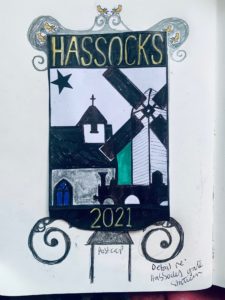
LOOK OUT FOR THESE LOCAL FEATURES ON THE SIGN
Three Stars
Adastra Park is owned by the Parish Council. After the First World War, local resident Edward Stafford donated Adastra Park to the village. Sadly, in 1917, his eldest son, Ewart, was killed in action whilst serving with the Royal Flying Corps during the Great War. Following his loss, Edward Stafford commissioned the landscaping of a strip of his garden to create what is now known as The Garden of Remembrance in memory of Ewart and the other young men who lost their lives. Edward Stafford also donated a further six acres of his garden to create a recreation ground, Adastra Park, and his Villa to the Salvation Army, Villa Adastra.
After the war, the R.F.C. was renamed the R.A.F. The name Adastra Park was taken from the official motto of the Royal Air Force ‘Per ardua ad astra’; a Latin phrase meaning “through adversity to the stars”. Hence the three stars on the village sign. There’s more information online about the Garden of Remembrance written by local historian, Penny Worth: https://keymerclaytonwarmemorials.wordpress.com/
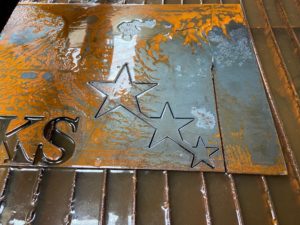
A Steam Engine, Hassocks
The area now occupied by Hassocks was just a collection of small houses and a coaching house until the 19th century, when work started on the London to Brighton Railway. The directors of the London, Brighton & South Coast Railway named the station Hassocks Gate. The name of the station was eventually changed to Hassocks in 1880.
The sign includes a silhouette of a steam engine of the type in use when the line opened in 1841; the scroll works around the sign are reminiscent of the fancy flourishing works seen on the facade of the original station.
St John the Baptist’s Church, Clayton
St John the Baptist’s Church sits at the foot of the South Downs, in Clayton village, and is the only Grade 1 listed building in Hassocks. Much of the Anglo-Saxon Church structure dates from the 11th-century and it’s notable for wall paintings from the early 12th century, rediscovered over 700 years later. It seemed fitting to incorporate this historic church into the design of the sign.
Oldland Mill, Keymer
Built in 1703, Oldland Mill is situated at the top of Oldlands Lane in Keymer. The mill hasn’t always looked as splendid as it does today. After 200 years of grinding, it sadly fell into disuse and deteriorated into a sorry state. However, in the 1980’s renovations began on the Mill thanks to a group of dedicated volunteers, and, in 1997, the Oldland Mill Trust was formed. In 2011, in recognition of the considerable effort and high standard of work undertaken in restoring the mill, the Trust was awarded the prestigious Sussex Heritage Trust Award. Further information about Oldland Mill is available at www.oldlandwindmill.org.uk.
The South Downs
The South Downs are visible from Hassocks, Clayton and Keymer and are prominent, much enjoyed feature of the locality, as well as marking the southern boundary of the Parish.
The Martlet Birds – West Sussex County Council
The traditional crest of the County of Sussex displays six gold Martlets, as does the coat of arms for West Sussex. Therefore, the Martlet bird has been included on the village sign in reference to Hassocks being within the County of West Sussex.
CREATING THE SIGN.
When a suitable design draft had been agreed, several local blacksmiths were approached, leading to the appointment of Dan Tester, a blacksmith based at Nutley, to fabricate the sign, a post and sleeve. A suitable piece of Oak from Sussex was chosen and prepared.
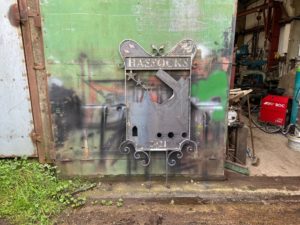
Once the sign had been fabricated, it was delivered to Jo Myles to be painted.
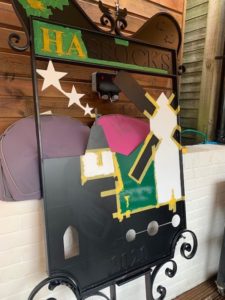
THE VILLAGE SIGN
After much anticipation, at the end of November 2021, this carefully crafted sign special to Hassocks was ready for installation. Local builder, Jon Barker, was appointed to install the new sign at the entrance to Adastra Park where it can be appreciated by all for many years to come.
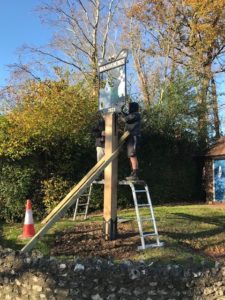
See full list of 2024/25 meetings, minutes and agendas here >
17/07/2025
Grounds & Environment Committee
28/07/2025
Planning Committee
See full list of 2024/25 meetings, minutes and agendas here >